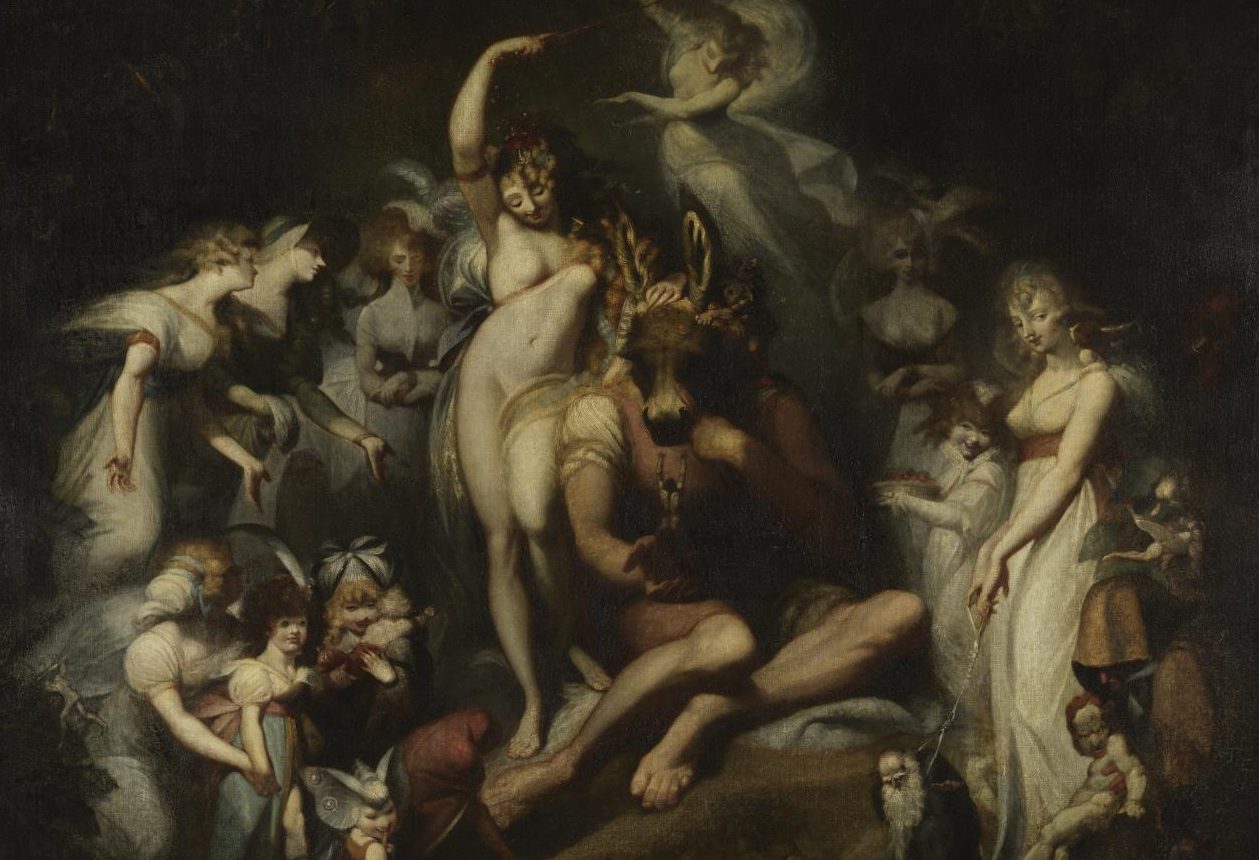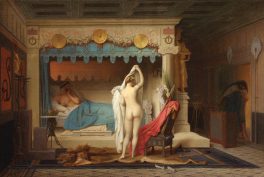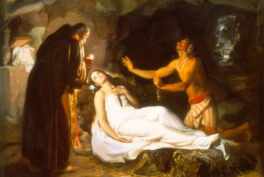Summary
- William Shakespeare’s plays inspired some of the most iconic paintings in art history.
- Henry Fuseli and John Singer Sargent painted scenes from Macbeth.
- Fuseli also put a painterly spin on Titania and Bottom from A Midsummer Night’s Dream, and so did Edwin Landseer.
- Ophelia from Hamlet was a popular Shakespeare character among artists. Pre-Raphaelite depictions often focus on her death.
- Edwin Austin Abbey is known for illustrating King Lear.
- Two Richard III paintings interpret the story of Lady Anne, a victim of a bloody intrigue, and David Garrick, a famous English actor.
- Théodore Chassériau’s etching shows Desdemona in Othello shortly before her tragic death.
- Benjamin West’s Romeo and Juliet is a political allegory.
- The most famous illustration of Shakespeare’s Miranda is that of John William Waterhouse, who delivered an epic depiction of a revenge.
1. Macbeth
Macbeth is a tragedy about the damaging consequences of political ambition. Written during the reign of James I, the play centered on accounts of Macbeth, King of Scotland, Macduff, and Duncan in Holinshed’s Chronicles (1587). Because some believe it is cursed, it is bad luck to mention the play by its title aloud in a theatre — many actors and directors refer to it instead as “the Scottish Play.”
Lady Macbeth Stealing the Daggers
Henry Fuseli (1741–1825) was a Romantic Swiss painter whose artworks focused on supernatural subjects; you might be familiar with his painting The Nightmare. He was introduced first to Shakespeare’s plays during his years spent in Switzerland when he translated Macbeth into German.
Art historians suppose that Lady Macbeth Stealing the Daggers is a sketch for a larger project. As a Romantic, Fuseli was interested in capturing the moment’s tension. This painting depicts Act II, Scene 2 when Lady Macbeth seizes the bloody daggers from her husband. Macbeth is terrified by his horrendous deed, killing the King of Scotland in his sleep, and unable to cope, confessing that “I am afraid to think what I have done; Look on’t again I dare not.” Hence, Lady Macbeth takes control of the situation and asks for the daggers.
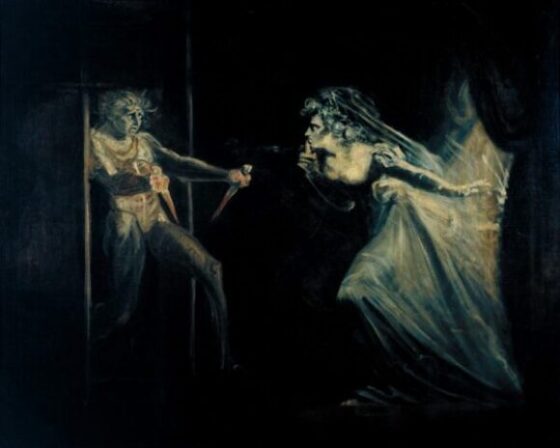
Shakespeare in Art: Henry Fuseli, Lady Macbeth Seizing the Daggers, exhibited c. 1812, Tate Britain, London, UK. Museum’s website.
The Three Witches
The weird sisters from Macbeth are sometimes considered the inverted portrayal of the three Fates, dressed in white gowns from ancient Greek mythology, responsible for deciding the people’s destiny at birth. In comparison, by predicting Macbeth’s future, the three witches push him to his downfall as he turns into a power-hungry tyrant. Similar in appearance, with thin lips and vaguely androgynous features, Fuseli follows Shakespeare’s description of the witches in portraying them:
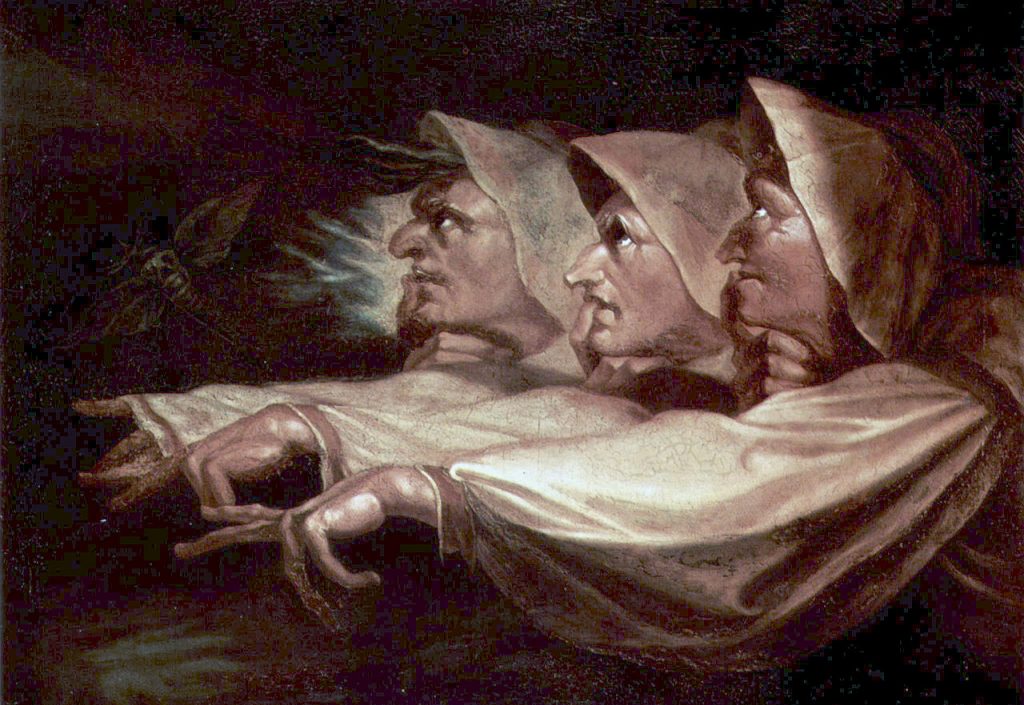
Shakespeare in Art: Henry Fuseli, The Three Witches, 1783, Kunsthaus, Zürich, Switzerland. Wikipedia Commons (public domain).
What are these,
So wither’d and so wild in their attire,
That look not like th’ inhabitants o’ the earth,
And yet are on’t? Live you? or are you aught
That man may question? You seem to understand me,
By each at once her choppy finger laying
Upon her skinny lips: you should be women,
And yet your beards forbid me to interpret
That you are so.
Macbeth, Act I, Scene 3.
Ellen Terry as Lady Macbeth
After seeing her perform, John Singer Sargent (1856–1925) asked the famous actress Dame Ellen Terry to pose as Lady Macbeth. While Sargent invented her pose, it did not appear in the original play. Terry’s attire is undoubtedly impressive: her blue and green robes contrast with her long red dreads decorated with golden ribbons. Although an American artist, Sargent was remarkably active in Europe, especially as a known leading portraitist.
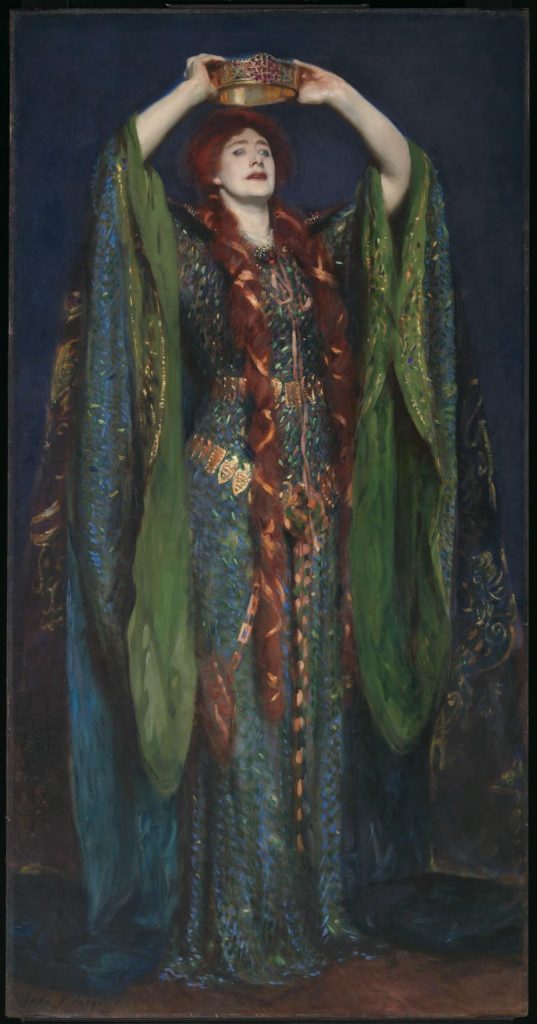
Shakespeare in Art: John Singer Sargent, Ellen Terry as Lady Macbeth, 1889, Tate Britain, London, UK. Wikipedia Commons (public domain).
2. A Midsummer Night’s Dream
With many subplots, this comedy is set in Athens and centered around the wedding of Theseus and Hippolyta. In a parallel plot, Oberon, king of fairies, punishes Titania, queen of fairies, for her refusal to give him her Indian changeling.
Titania and Bottom
Another Fuseli painting, Titania and Bottom, depicts Act IV, Scene 1 from A Midsummer Night’s Dream, in which Oberon spell bounds Titania to fall in love with Bottom, an artisan with the head of an ass. Titania’s pose was inspired by Leonardo da Vinci’s Leda, whereas the elves on the right resemble Sandro Botticelli‘s illustration of Canto XXX of Dante‘s Paradiso. This play appealed to Fuseli as he was fascinated by the supernatural realm and its representation in art.
The young woman holding onto a dwarfish creature supposedly symbolizes the victory of youth and beauty over old age, the sense over the mind, and the feminine over the masculine. The group of fairy children on the left of the picture are creatures created by witches. On the right, a hooded figure is holding a changeling in its arms: a child believed to be replaced by fairies for the parent’s real infant child. What a spectacle!
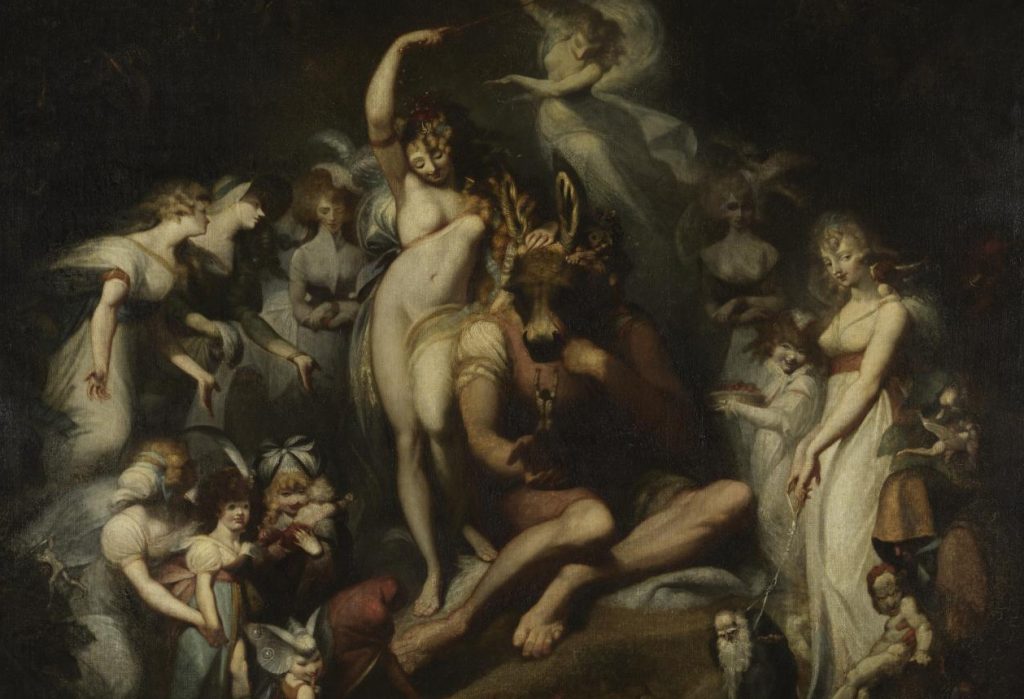
Shakespeare in Art: Henry Fuseli, Titania and Bottom, c. 1790, Tate Britain, London, UK. Museum’s website.
Scene from A Midsummer Night’s Dream
On a similar note, this is another rendition of Titania and Bottom in the third act of the play, painted by Edwin Landseer (1802–1873). Surrounded by flowers and rabbits, Titania, drugged with a love potion, rests her head on Bottom’s shoulder. By Titania’s right, you can find Puck, one of the first male fairy characters, Oberon’s aid, and the one who gave Bottom an ass head. Puck’s pointed years have inspired the portrayal of fairies in art.
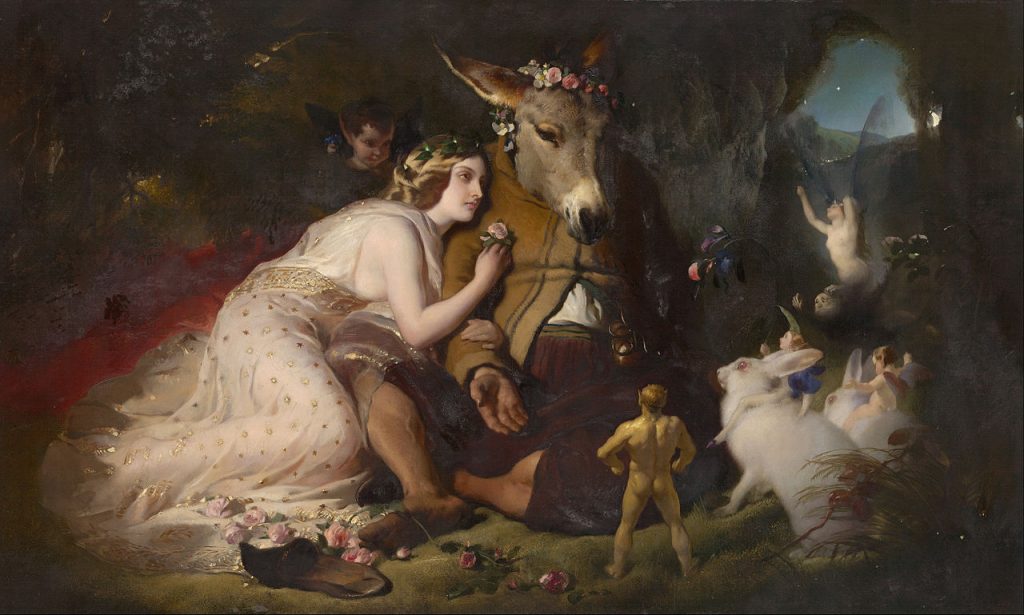
Shakespeare in Art: Edwin Landseer, Scene from A Midsummer Night’s Dream. Titania and Bottom, between 1848 and 1851, National Gallery of Victoria, Melbourne, Australia. Wikipedia Commons (public domain).
3. Hamlet
The Tragedy of Hamlet, Prince of Denmark is Shakespeare’s lengthiest play. Set in Denmark, this tragedy is about Prince Hamlet, who seeks revenge against his uncle, Claudius, his father’s murderer, and his mother’s new husband.
Ophelia
John Everett Millais (1829–1896) was an English painter and one of the founders of the Pre-Raphaelite Brotherhood. Given this, he painted with great accuracy and care. Despite being a relatively small painting (762 × 1118 mm), it took two years to complete Ophelia. To give you an idea of the effort that went into this artwork, it required the model to pose for over four months in a bathtub full of water.
This painting is a rendition of Act IV, Scene 7, in which Ophelia, in a state of madness, drowns herself in a stream of water after her lover, Hamlet, cancels their betrothal and murders her father by accident.
And, mermaid-like, awhile they bore her up;
Which time she chanted snatches of old tunes,
As one incapable of her distress,
Or like a creature native and indued
Unto that element; but long it could not be
Till that her garments, heavy with their drink,
Pull’d the poor wretch from her melodious lay
To muddy death.The Tragedy of Hamlet, Prince of Denmark, Act 4, Scene 7.
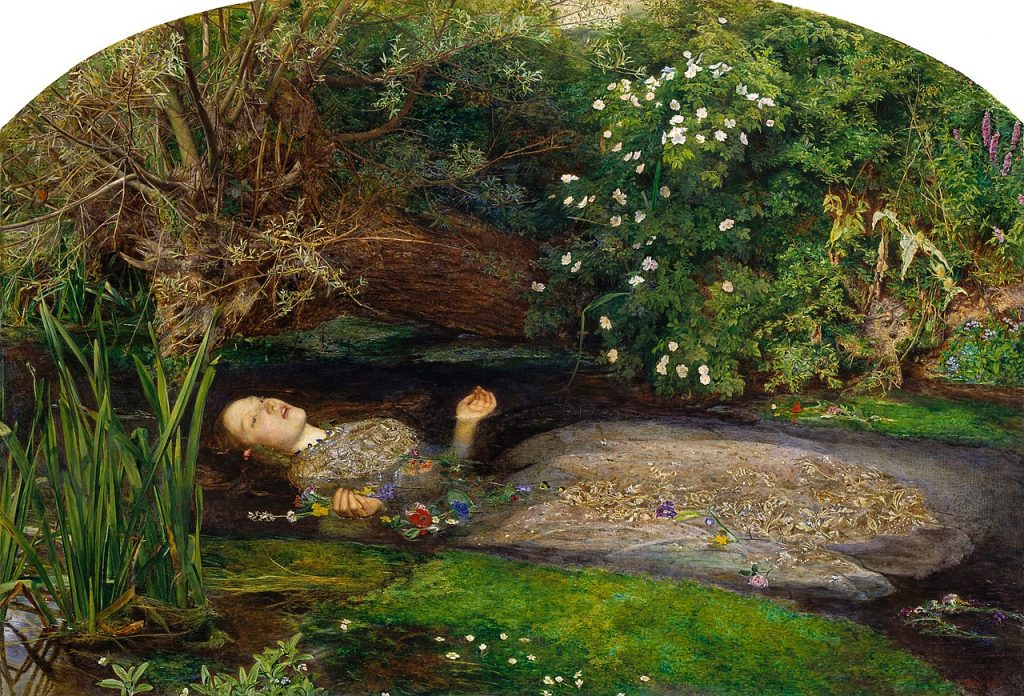
Shakespeare in Art: John Everett Millais, Ophelia, 1851–1852, Tate Britain, London, UK. Wikipedia Commons (public domain).
Most vegetal elements bear a symbolic significance. For instance, the roses surrounding Ophelia may refer to her brother’s nickname for her, the “rose of May.” Close by, the willow, nettle, and daisy represent symbols of forsaken love, pain, and innocence, whereas the violets she wears around her neck signify faithfulness, chastity, or the death of the young.
Ophelia was very popular among Victorian painters, regularly featuring in the exhibitions of the Royal Academy. A similar painting by John William Waterhouse (1849–1917) depicts Ophelia sitting on a willow branch in her final moments before death.
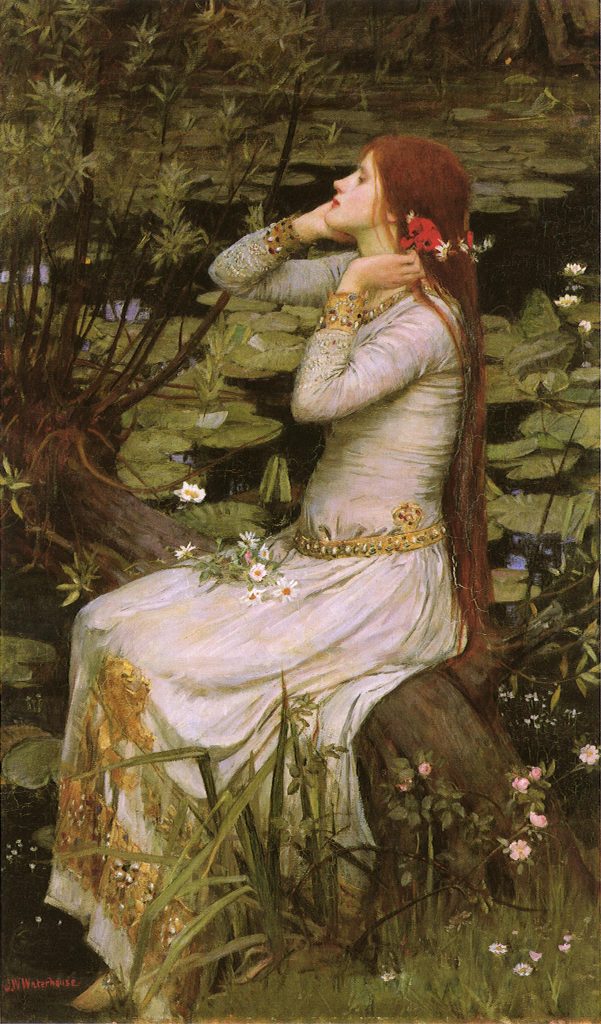
Shakespeare in Art: John William Waterhouse, Ophelia, 1894, private collection. Wikipedia Commons (public domain).
4. King Lear
King Lear is a tragedy based on the legendary Leir of Britain. At the end of his reign, King Lear wanted to divide his power between his three daughters, Goneril, Regan, and Cordelia. Cordelia is the only one who refuses to profess her love for him in exchange for a third of his kingdom.
King Lear, Act I, Scene I
Also known as Cordelia’s Farewell, this painting depicts the tragedy’s opening scene, when Cordelia, standing at the center of the composition, is renounced by her father. Joined by her two sisters dressed in black and red, Cordelia is the only feminine character wearing white robes, symbolizing her purity. Edwin Austin Abbey (1852–1911) often adopted historical themes in his art, best known for his Arthurian and Shakespearean subject matters.

Shakespeare in Art: Edwin Austin Abbey, Cordelia’s Farewell, 1898, The Metropolitan Museum of Art, New York, NY, USA. Wikipedia Commons (public domain).
5. Richard III
Richard III focuses on the short reign of King Richard III of England and the unscrupulous pursuit of power. Considered by some a historical play and, by others, a tragedy, Richard III is the last play in Shakespeare’s first tetralogy, the First Folio.
Richard, Duke of Gloucester, and the Lady Anne
In this scene, the hideous humpbacked Richard, Duke of Gloucester, attempts to court the recently widowed Lady Anne, whose husband Richard, himself, had stabbed. Moreover, they are at the funeral procession of her father-in-law, King Henry VI, also killed by Richard. He confesses to Lady Anne that he killed the two men to get closer to her, and although at first she is angered by this, the two of them marry, and Richard becomes the next king of England.
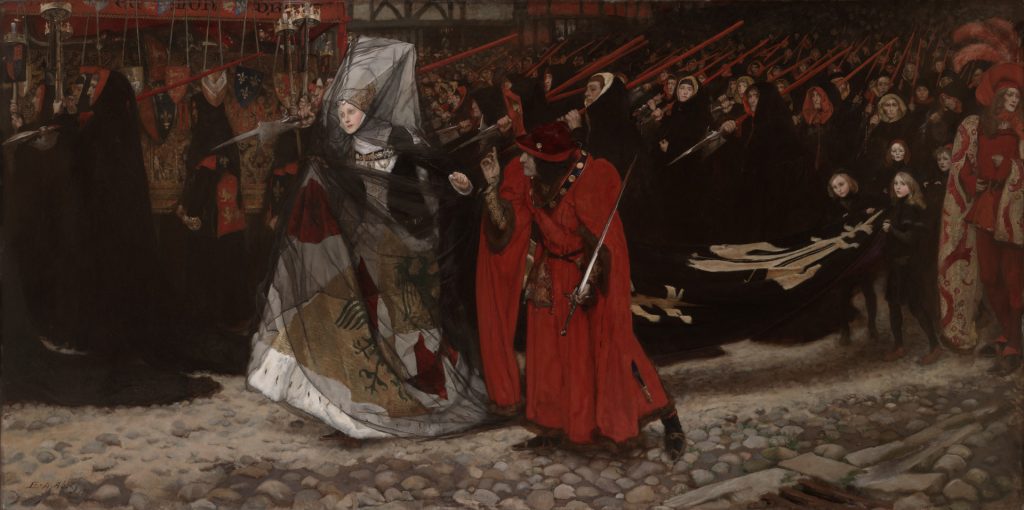
Shakespeare in Art: Edwin Austin Abbey, Richard, Duke of Gloucester, and the Lady Anne, 1896, Yale University Art Gallery, New Haven, CT, USA. Wikipedia Commons (public domain).
David Garrick as Richard III
David Garrick, one of the greatest English actors to have ever lived, earned his glory after playing the role of Richard III in Shakespeare’s play. Here, he is in the tent before the Battle of Bosworth, frightened by the ghosts of his past victims. Garrick’s position follows a “serpentine” line – a stretched “S” about which William Hogarth (1697–1764) wrote in his theoretical treatise The Analysis of Beauty, published in 1753.
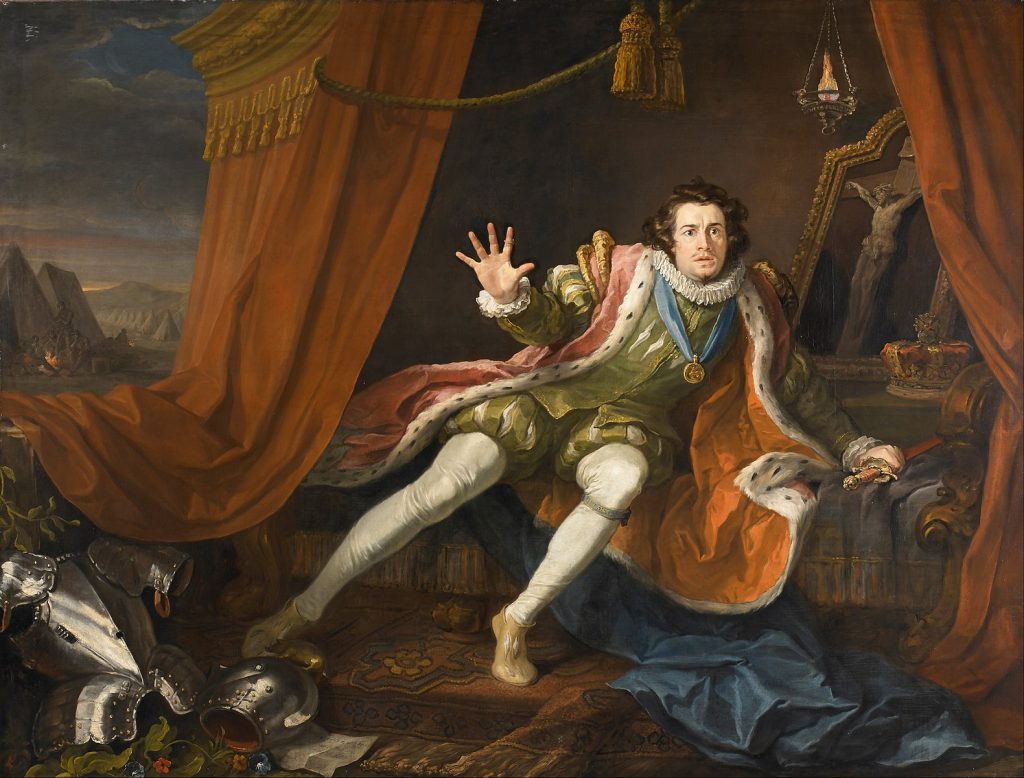
Shakespeare in Art: William Hogarth, David Garrick as Richard III, c. 1745, Walker Art Gallery, Liverpool, UK. Wikipedia Commons (public domain).
6. Othello
The Tragedy of Othello, the Moor of Venice is set in the 16th century during the contemporary Ottoman–Venetian War. Othello is a military commander and a general commander of the Venetian army. Some themes include jealousy, passion, and even race, as Othello is Moorish.
Desdemona (The Song of the Willow)
The painting depicts Act IV, Scene 3, with Desdemona and her maid, Emilia, in her chamber. Her husband, Othello, kills her in a fit of jealousy after being deceived by Iago, his stead-bearer. Emilia fades away in the background as she is complicit in his wife’s death. The lyre in Desdemona’s lap was not described in the original play but added by the artist. Théodore Chassériau (1819–1856) illustrated Shakespeare’s Othello in a series of etchings, published in Paris in 1844; one of them served as inspiration for this artwork.

Shakespeare in Art: Théodore Chassériau, Desdemona (The Song of the Willow), 1849, The Metropolitan Museum of Art, New York, NY, USA. Wikipedia Commons (public domain).
7. Romeo and Juliet
“O Romeo, Romeo! Wherefore art thou Romeo?” Yet another Shakespearian tragedy, Romeo and Juliet, showcases the story of two young star-crossed lovers whose families opposed their union in marriage. The play is set in Italy and is probably Shakespeare’s most famous tragedy.
Romeo and Juliet
Romeo and Juliet are in her chamber, guarded by a housemaid who, presumably, is scared that someone might walk in on them. Beyond the large open window, dark, ominous clouds announce a storm, possibly a reference to the lovers’ terrible deaths.
Benjamin West (1738–1820) was known for painting modern battles and, like many of his contemporaries, painted scenes from theatre plays to illustrate contemporary social events. Art historians argue that the theme of the star-crossed lovers alludes to the conflicts between Britain and the United States at the beginning of the Revolutionary War.
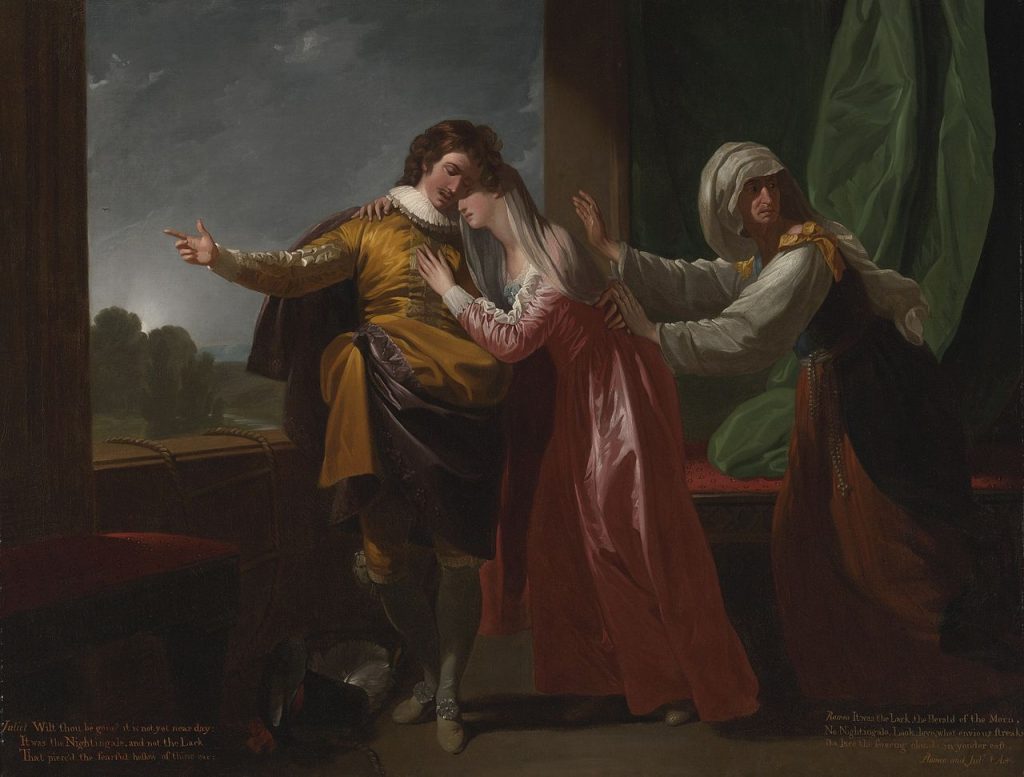
Shakespeare in Art: Benjamin West, Romeo and Juliet, 1778, New Orleans Museum of Art, New Orleans, LA, USA. Wikipedia Commons (public domain).
8. The Tempest
In The Tempest, Prospero, powerful magician and former Duke of Milan, lives on a solitary island with his daughter, Miranda, and his two servants, Caliban, a savage monster, and Ariel, an airy spirit. The play is famous for its music and songs that invoke the magical spirit of the island.
Miranda
Miranda is one of the main characters in Shakespeare’s The Tempest. She has turned our back to us and watches with sorrow the shipwreck caused by the powerful storm. Prospero’s brother, who stole his dukedom, was on that ship and, so, determined to regain his power, Prospero conjured a spell to destroy the vessel.
If by your art, my dearest father, you have
Put the wild waters in this roar, allay them.
The sky, it seems, would pour down stinking pitch,
But that the sea, mounting to th’ welkin’s cheek,
Dashes the fire out. Oh! I have suffered
With those that I saw suffer: a brave vessel,
Who had, no doubt, some noble creatures in her,
Dash’d all to pieces. Oh! The cry did knock
Against my very heart. Poor souls, they perish’d.The Tempest, Act 1, Scene 2.
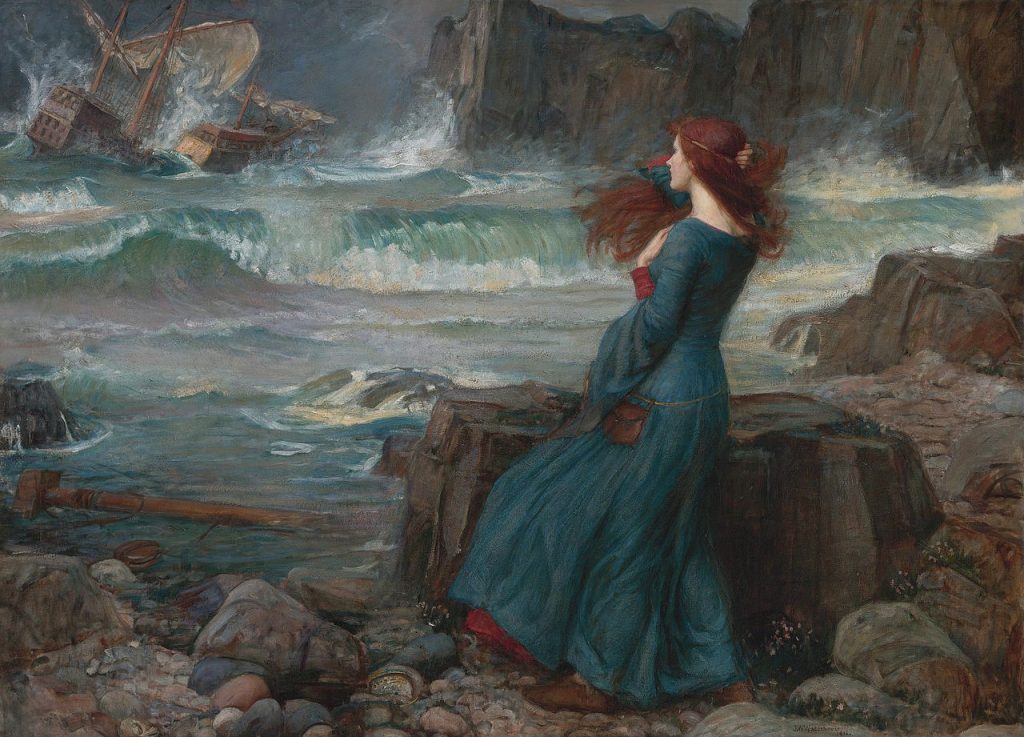
Shakespeare in Art: John William Waterhouse, Miranda – The Tempest, 1916, private collection. Wikipedia Commons (public domain).
